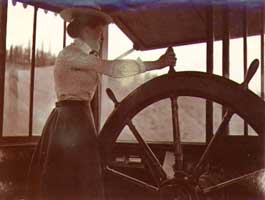William E. Meed Photographs
Selections from William Meed's Journal
Sample Searches
- Chilkoot Pass
- Dawson
- Gold mining
- Meed family
- Steamboats
- Yukon Indians
- George Cantwell, photographer
- H.J. Goetzman, photographer
- Eric Hegg, photographer
- Kinsey and Kinsey, photographers
Other Resources
Klondike Gold Rush: The Perilous Journey North
The Evergreen State..in Black and White
Northwest of the West: The Frontier Experience on the Northwest Coast
William E. Meed was not a professional photographer, but he compiled one of the most important photographic records of the Klondike between the years 1898 and 1907. He collected photographs by well known photographers and included snapshots taken by himself and his friends which he later supplemented with a narrative account in a binder of handwritten notes.
William E. Meed, with his wife Mabel, went to Dawson, Yukon Territory, Canada, in 1898, where he worked in river transportation for about ten years. The Meeds moved to Victoria, British Columbia, about 1907, where William was an orchardist and manager of a shipyard. Little is know of intervening years, but by 1936, William Meed was a salesman living alone in Vancouver, B. C., near his daughter Edna. In the 1940s, he wrote reminiscences of his Klondike experiences for a Vancouver newspaper.
William Meed compiled an extensive documentary collection of some 233 Klondike-related photographs. Some of these were taken by prominent commercial photographers, while others were snapshot photographs taken by himself and his friends. The collection is accompanied by a series of captions derived from what Meed called his Journal, a narrative account of his Klondike experiences that is keyed to the photographs. The materials were saved by his daughter, Edna Meed, from whom they were acquired in 1986.
Many of the photographs are by well-known photographers such as Eric A. Hegg, Kinsey & Kinsey (Clark Kinsey and Clarence Kinsey), H. J. Goetzman, H. C. Barley, and George G. Cantwell. These depict Klondike mines and mining activities in the Dawson vicinity, Dawson street scenes, views along the Chilkoot Trail and the White Pass & Yukon Route railroad, steamboats and steamboat landings, and other Klondike scenes. William E. Meed was an amateur photographer himself, and took a number of photographs that document his own activities, his wife and family, his friends, and his fellow workers for the Stewart River Co. and aboard the steamboat Prospector.The snapshots show Dawson's cabin residences, the Dawson docks and freighting activities, outings by dogsled, wilderness roadhouses, and domestic scenes.
William Meed became the freight and passenger agent for the Bennett Lake and Klondike Navigation Co. shortly after his arrival at Dawson in 1898. The company operated the vessels Ora, Nora, and Flora between Whitehorse and Dawson. He soon also became agent for the Canadian Development Co., which operated the steamboats Victorian, Columbian, and Canadian.
At the turn of the century, Meed became chief owner and manager of the Yukon Dock Company at Dawson. He then formed the Stewart River Co. on December 22, 1900, for the purpose of building and operating the first boat that was suitable for navigating the Stewart River. The sternwheel steamer Prospector was built in Whitehorse in 1901, the name indicating the exploratory purpose of the boat, and also identifying it with those men whom it was intended to serve. The Prospector was designed by a prominent Victoria boat builder, and Capt. James A. Ritchie was given command of the vessel.
In addition to pioneering service on the Stewart River, the Prospector first attempted navigation on the Pelly River and Macmillan River. Meed took photographs along these routes, and along the Yukon River from Whitehorse to Dawson, and downstream to Eagle, Alaska, a route later served by the Prospector.
About the Database
The descriptive data for the images in William E. Meed Photographs is derived from information supplied by William E. Meed as transcribed by his daughter, Edna Meed and acquired with the photographs in 1989. The information was entered directly into the UW CONTENT program, which links the information directly to the digital images. The Meed photographs vary in size, from snapshots of approximately 4"x5" to 8"x10", with some larger images up to 8"x60". Most photographs were scanned using a Microtek Scanmaker 9600XL and saved in .jpg format. Some photographs are mounted in an album that precludes direct scanning; these image were recopied as 35mm color transparencies, and then scanned.
William E. Meed Photographs was prepared for electronic access by the UW Libraries staff. Research, writing, and image scanning were done by Kristin Kinsey. Additional research assistance was provided by Richard Engeman and volunteer Noriko Low. Photographic work for the project was provided by a grant from Foster Pepper & Shefelman PLLC, Seattle.
The original collection resides in the UW Libraries Special Collections Division as the William E. Meed Collection no. 246.


